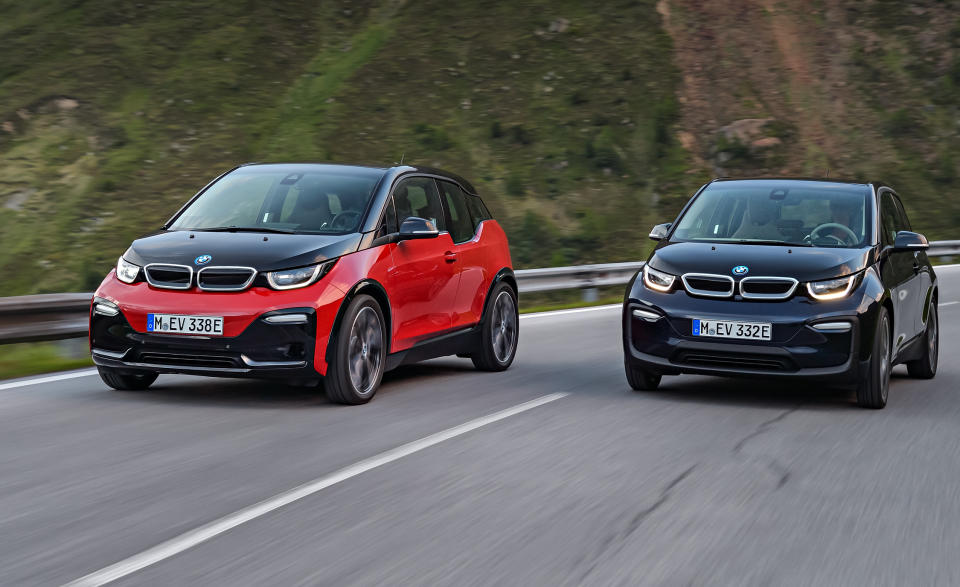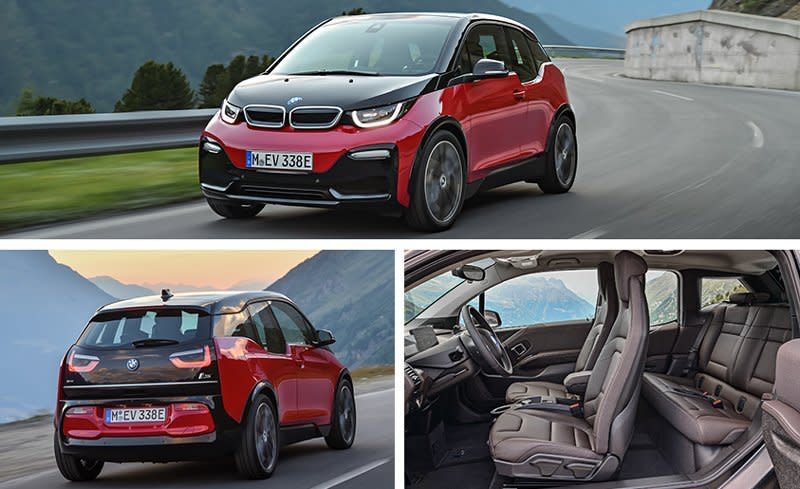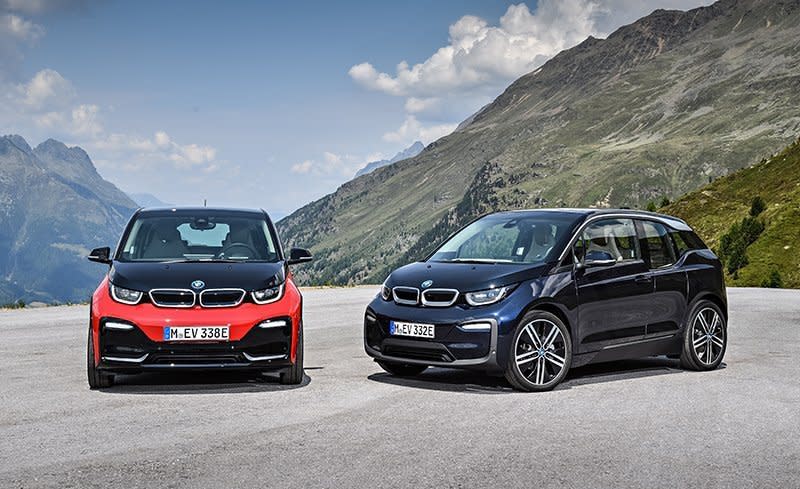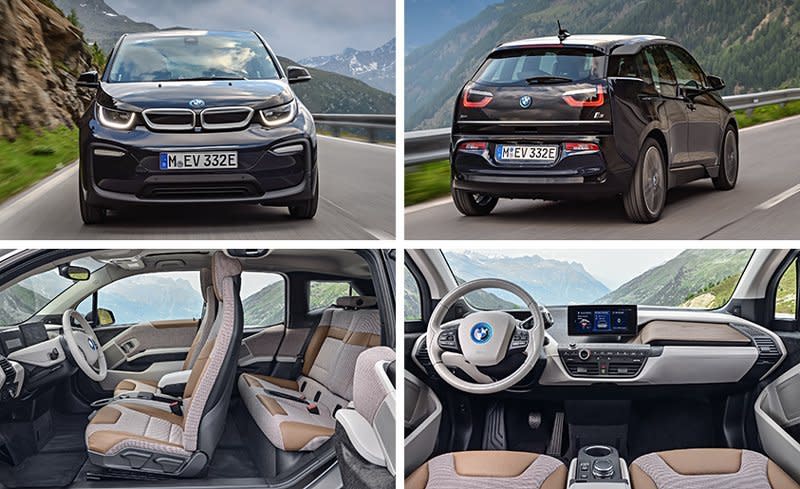2018 BMW i3 and i3s: Updates and a New Sporty Variant

Four years after its introduction, BMW’s unabashedly quirky i3 electric city car finally is getting something that the brand’s traditional customers expect: a performance variant. Ahead of the Frankfurt auto show, where BMW also is expected to reveal an all-electric 3-series prototype, the German automaker has revealed a model with an s suffix—the i3s—as part of a modestly revamped i3 lineup for 2018.
The 2018 BMW i3s gets more than a facelift and a pep talk, as BMW says it accelerates more quickly, runs to a higher top speed, and rides 0.4 inch lower on a wider track. The i3s whirls out 184 horsepower and 199 lb-ft of torque compared with the standard model’s 170 horses and 184 lb-ft, thanks to modified motor controls and tapered roller bearings that help its high-rpm performance.

It’s not Insane or Ludicrous, but BMW says the added grunt allows the all-electric i3s to get to 60 mph in 6.8 seconds. It took the standard model 7.2 seconds to hit 60 mph in our most recent test of one equipped with the range-extending engine; the best we’ve seen was 6.5 seconds in an electric-only 2014 i3. BMW also says the i3s tops out at 100 mph rather than 93 mph (the standard model reached 92 mph in our tests), and it should handle such speeds with more verve, as the i3s gets 20-inch wheels that are an inch larger and a half-inch wider than those of the basic i3, as well as revised tuning for the springs, dampers, and anti-roll bars, plus a Sport mode for the Driving Dynamics Control system that brings sharper accelerator response and modified steering.
On all updated i3 models, the stability-control system has been retuned for sportier driving and high-speed handling situations, with BMW boasting that the system in this rear-wheel-drive compact now will allow mild drifts in reduced-grip situations.
The nudge to the sporty side doesn’t mean that the i3 will give up any eco-warrior status, though. Last year brought an optional larger battery—33.2 kWh compared with the base 21.6-kWh pack—that significantly increased the electric range from 81 miles to 114. (All 2018 i3 models utilize the larger pack.) Just like the standard i3, the i3s is available with a gasoline-powered, onboard range extender. The i3s’s range extender is the same 647-cc twin-cylinder powerplant with an intentionally small, regulatory-driven 2.4-gallon fuel tank that is employed on the regular i3. This setup is good for an EPA-rated combined total of 180 miles—the electric-only range is 97 miles—which still is short of what the Chevrolet Bolt EV can do on a single charge without the aid of onboard hydrocarbons.

Visually, the 2018 model changes boil down to a number of cosmetic tweaks. This isn’t surprising, as the i3 remains an advanced proving ground for engineering ideas, employing a top-hat body made of carbon-fiber-reinforced plastic and attached to a chassis made mostly of aluminum. The most dramatic new visual cue is that the A-pillar, which flows into the roofline and all the way back to above the floating D-pillar, is now painted gloss black; the non-s i3 also gets a matte-chrome roofline accent. This change could help the i3 look a little more visually balanced, although it always has been a vehicle that tends to show better in photographs than it does in the wild. In front, full LED headlamps now are standard, and the i3 gets rid of its round fog lamps in favor of a thinner-profile LED design. All 2018 i3 models also receive restyled front and rear bumpers, new side skirts, and a chrome trim strip on the hatch, while the i3s gets new gloss-black wheel-arch molding, model-specific bumpers, and additional gloss-black trim. Melbourne Red and Imperial Blue are two new exterior paint hues for 2018.
All 2018 i3 models get a new optional interior combination of Giga Brown natural leather and Carum Spice Grey cloth, as well as upgraded iDrive connectivity gear. For those who haven’t cozied up with an i3 before, it feels surprisingly spacious inside, thanks to the upright cabin, flat floor, and a back seat accessed by a set of rear-hinged doors. The materials are an eco-showcase, with more than 80 percent of the surfaces visible to the passengers made from recycled or renewable materials. Curiously, BMW hasn’t given the i3s what might help change the mood inside the most: a sportier steering wheel.
BMW’s latest iDrive 6 interface is employed on the new i3 range, with an available larger screen and natural-language voice inputs that may even outshine Siri, although users also can employ Apple CarPlay (but not Android Auto). On-Street Parking Information uses historical and real-time data to help find a spot, and with Connected and Connected+ services you can use intelligent route planning to manage charging-station stops as well as send route instructions from a smartphone to the car or vice versa, among other features.

BMW aims to provide many different charging options to i3 owners. All i3 models get an upgraded charging cable with a temperature sensor. BMW also offers a new TurboCord accessory for $499 that can charge either with a standard 120-volt household socket or at three times the rate by plugging into a NEMA 6-20 receptacle on a 20-amp, 240-volt connection. Further invest into your home setup with a BMW i Charging Station and the connection will deliver 7.2 kilowatts of juice, or 90 miles of range, in roughly three hours.
Timing is everything, especially in the rapidly evolving electric-vehicle (and battery) market. With a next-generation i3 reported to be about four years away and an all-electric 3-series and Mini Hardtop due to arrive before then, where does that leave this version of the i3? Even with all these changes, the i3 appears to be what it always has been, a distinctive and niche choice even among electric cars. What remains to be seen is whether the i3s model brings it more of what, for generations, has attracted those who love driving to the BMW brand.
Pricing and more information will be released closer to launch, which is expected in late 2017.

 Yahoo Finance
Yahoo Finance 